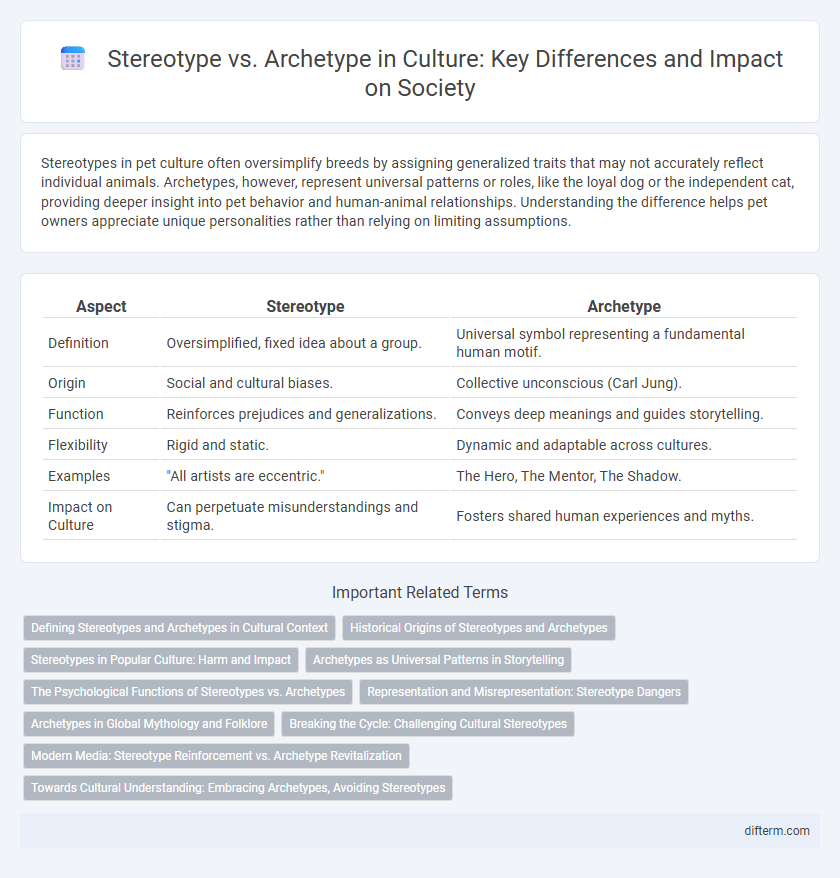Stereotypes in pet culture often oversimplify breeds by assigning generalized traits that may not accurately reflect individual animals. Archetypes, however, represent universal patterns or roles, like the loyal dog or the independent cat, providing deeper insight into pet behavior and human-animal relationships. Understanding the difference helps pet owners appreciate unique personalities rather than relying on limiting assumptions.
Table of Comparison
| Aspect | Stereotype | Archetype |
|---|---|---|
| Definition | Oversimplified, fixed idea about a group. | Universal symbol representing a fundamental human motif. |
| Origin | Social and cultural biases. | Collective unconscious (Carl Jung). |
| Function | Reinforces prejudices and generalizations. | Conveys deep meanings and guides storytelling. |
| Flexibility | Rigid and static. | Dynamic and adaptable across cultures. |
| Examples | "All artists are eccentric." | The Hero, The Mentor, The Shadow. |
| Impact on Culture | Can perpetuate misunderstandings and stigma. | Fosters shared human experiences and myths. |
Defining Stereotypes and Archetypes in Cultural Context
Stereotypes in cultural contexts represent oversimplified and fixed generalizations about groups, often leading to misleading assumptions and reinforcing biases. Archetypes, by contrast, are universal, recurring symbols or themes found across various cultures, embodying fundamental human experiences and collective unconscious patterns. Understanding the distinction enhances cultural awareness and promotes more accurate interpretations of social behaviors and narratives.
Historical Origins of Stereotypes and Archetypes
Historical origins of stereotypes often stem from oversimplified and generalized portrayals of groups influenced by social, political, and economic power dynamics. Archetypes, rooted in collective unconscious concepts introduced by Carl Jung, represent universal, symbolic figures recurrently found across cultures and mythologies. Whereas stereotypes reduce complex identities to fixed traits, archetypes serve as foundational motifs that shape cultural narratives and individual identities.
Stereotypes in Popular Culture: Harm and Impact
Stereotypes in popular culture often perpetuate oversimplified and inaccurate depictions of social groups, reinforcing harmful biases and limiting complex identities to cliched roles. These distorted portrayals can influence public perception, contributing to prejudice, discrimination, and marginalization of marginalized communities. Unlike archetypes, which serve as universal, symbolic models in storytelling, stereotypes lack nuance and sustain cultural misunderstandings with lasting social consequences.
Archetypes as Universal Patterns in Storytelling
Archetypes serve as universal patterns in storytelling, representing fundamental human experiences and emotions shared across cultures and time periods. These timeless symbols and characters, such as the Hero, the Mentor, and the Shadow, provide a framework for narratives that resonate deeply with audiences worldwide. Unlike stereotypes, which are oversimplified and fixed ideas about groups, archetypes offer a dynamic and meaningful structure that enriches cultural stories and fosters understanding.
The Psychological Functions of Stereotypes vs. Archetypes
Stereotypes function psychologically by simplifying social information, enabling quick judgments and reducing cognitive load, but often leading to oversimplified and inaccurate perceptions of groups. Archetypes serve deeper psychological functions by embodying universal patterns and themes in the collective unconscious, guiding personal development and cultural narratives. While stereotypes create fixed, surface-level assumptions, archetypes provide a dynamic framework for understanding human behavior and shared cultural myths.
Representation and Misrepresentation: Stereotype Dangers
Stereotypes oversimplify cultural identities, reducing diverse groups to limiting and often false characteristics, which fuels prejudice and social division. Unlike archetypes that serve as universal symbols reflecting shared human experiences, stereotypes distort representation, leading to harmful misrepresentations and reinforcing biases. Accurate cultural representation requires moving beyond stereotypes to honor complexity and individual narratives.
Archetypes in Global Mythology and Folklore
Archetypes in global mythology and folklore represent universal symbols and characters that embody fundamental human experiences, such as the Hero, the Shadow, and the Trickster. These recurring motifs transcend cultural boundaries, providing a shared narrative structure that reveals common psychological patterns across societies. Unlike stereotypes, which are oversimplified and often inaccurate portrayals, archetypes serve as profound, symbolic templates that enrich cultural storytelling and collective identity.
Breaking the Cycle: Challenging Cultural Stereotypes
Breaking cultural stereotypes requires recognizing their difference from archetypes, which are universal symbols reflecting collective human experiences rather than rigid, oversimplified traits. Challenging stereotypes involves promoting diverse narratives that reflect authentic cultural complexities and individual identities. Empowering communities to tell their own stories disrupts harmful generalizations and fosters mutual understanding and respect.
Modern Media: Stereotype Reinforcement vs. Archetype Revitalization
Modern media often perpetuates cultural stereotypes by simplifying characters into fixed, predictable roles that reinforce existing biases, limiting audience understanding. In contrast, archetype revitalization in contemporary storytelling reinterprets traditional figures with depth and nuance, fostering cultural reflection and growth. This shift enriches narratives by challenging cliches and promoting diverse, multifaceted representations in film, television, and digital platforms.
Towards Cultural Understanding: Embracing Archetypes, Avoiding Stereotypes
Archetypes represent universal symbols and themes deeply rooted in human experience, fostering cultural understanding by highlighting shared values and narratives across societies. Stereotypes, often oversimplified and rigid, distort cultural identities and perpetuate misconceptions that hinder genuine connection. Embracing archetypes encourages empathy and respect, enabling individuals to appreciate cultural diversity beyond superficial assumptions.
stereotype vs archetype Infographic

 difterm.com
difterm.com